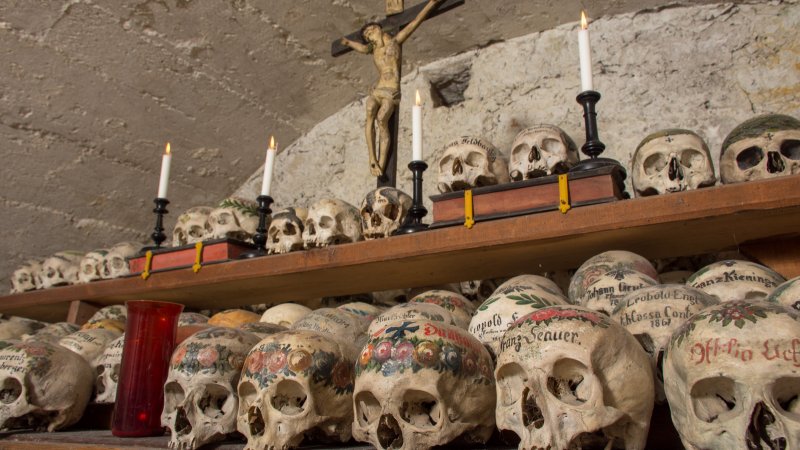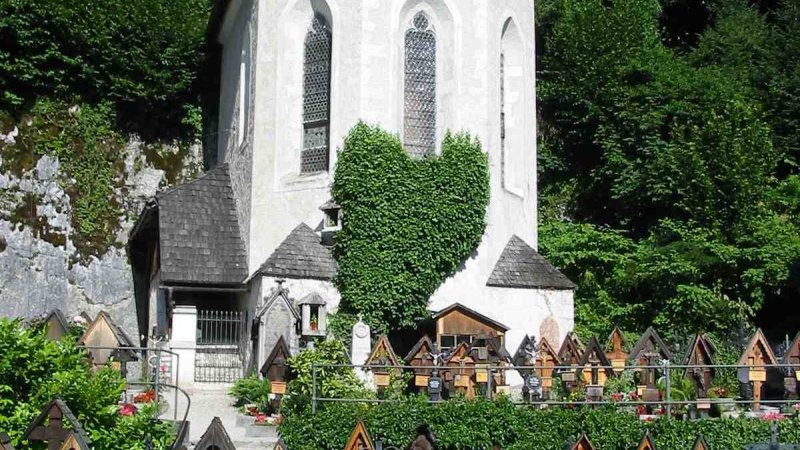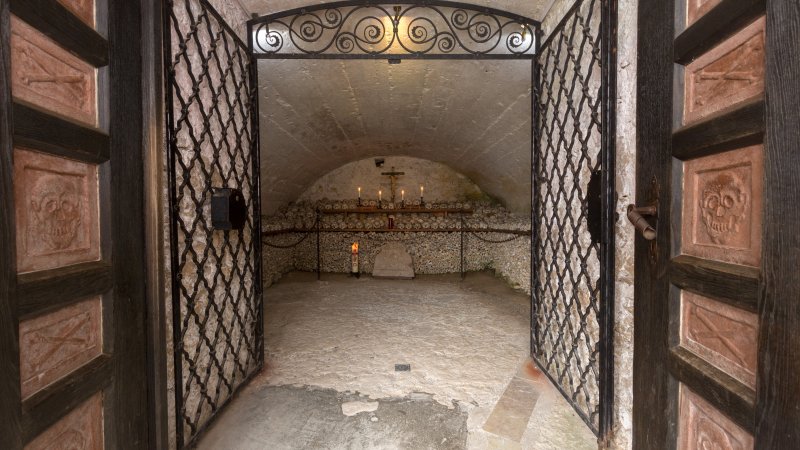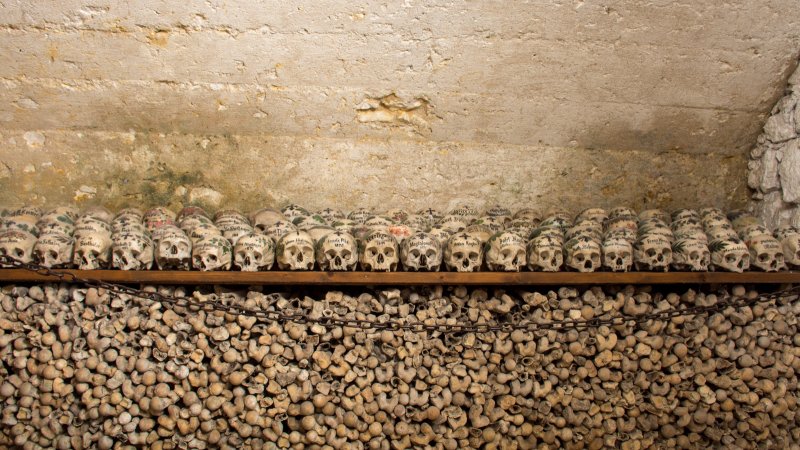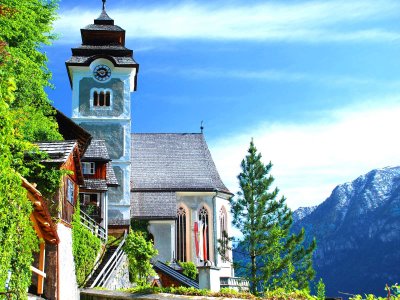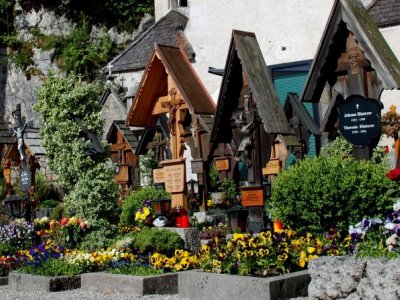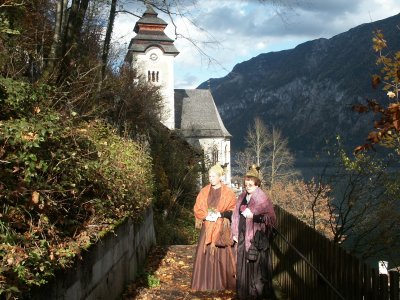Hallstatt Charnel House
The world-famous charnel house
in St. Michael’s Chapel
Alongside the world’s oldest salt mine and the idyllic, world-famous postcard view, the charnel house or ‘Bone House’ in St. Michael’s Chapel is one of the most interesting tourist sites in Hallstatt. The chapel dates back to the 12th century and is located next to the catholic parish church. Each year, visitors from throughout the world come to admire the unusual collection of over 600 artistically painted skulls. Many of the skulls were decorated at the end of the 18th century, but a few are from even the 20th century.
Historical Background
Skull painting was carried out primarily during the 19th century and belonged to a cultural area that mainly consisted of the eastern Alpine region (the Austrian Innviertel, Upper Austria, Salzburg, Tyrol, and Bavaria). Even during modern times, this custom has still been in use in Hallstatt. Hallstatt is home to the largest collection of skulls ever, with few other collections still in existence. When an existing grave was reused for a new burial, the skull or bones were transferred from the grave to the charnel house or ossuary as part of a second funeral. The identity of the deceased family member was preserved by decorative paintings and inscriptions. Depending on the family relationship or based on artist choice, the skulls were labelled with names or initials. At times, no markings were used to identify the deceased.
Although it is clear that various methods of painting were implemented, there is also evidence that the painting style followed a particular development. This evolution is also apparent in the manner in which the names and initials were written. Prior to a study from 1974 to 1993, there were conceptions regarding the painting which did not correspond with the actual artistic development. It was also accepted that the skulls had been placed in the charnel house due to a lack of space in the churchyard. During earlier investigations from 1948 to 1950, 2104 skulls, both painted and unpainted, were documented. Since there were approximately 30,000 entries in the church death registry prior to 1900, it is clear that the remains of the individuals housed in the charnel house represent only a small fraction of the deceased population.
There is evidence of family tradition in the skull paintings and numerous painters were active during this time period. With few exceptions, certain painting styles emerge as characteristic for particular eras. Skulls with wreaths are the oldest—the darker the wreath, the older the skull. Thin wreaths and coloured crosses with contoured edges are the latest examples of this type of painting. Flower ornamentation on the forehead marks the next phase of artistic development followed by green leaves on the temples (oak, ivy, oleander). A black cross on the forehead was almost always included.
The latest paintings from the beginning of the 19th century are characterized by thin ivy branches on either side of the skull, Latin script and comparatively narrow crosses. At times, skulls only carry the name of the individual. Some paintings are copies of earlier examples. During the last few years of the 20th century, very few skulls were interred in the charnel house.
St. Michael’s Chapel:
Home of the ‘Bone House’
Located adjacent to the picturesque cemetery and next to the catholic parish church, St. Michael’s Chapel is considered the home of the charnel house. Donated by the salt merchant Eysl in 1612, the baroque Michael Altar stands in the eastern section of the chapel. The baroque pulpit located on the northern wall was moved from the parish church in 1905. The rear altar originates from the former hospital chapel in the Hallstatt village district of Lahn. The two stone lanterns on the village side were once used during funeral masses. The exquisite stained-glass windows in the gothic section of the chapel, located in the upper story, depict St. Michael with the Balance of Life.
Our Tip: Combine your visit to the historical church grounds with an enjoyable, approximately half-hour stroll over the rooftops of Hallstatt (‘Über den Dächern von Hallstatt’) or along the informative themed path which leads through the entire village center.
Other sights around the Hallstatt Charnel House
Catholic Church of Hallstatt
Hallstatt | With the historic ossuary and the small mountain cemetery, the pilgrimage church is a fixture for visitors from all over the world. But it also contains an exciting criminal history ....
The cemetery of Hallstatt
Hallstatt | The cemetery: The rocky grounds of the parish church became the Hallstatt cemetery. The front is assigned the Evangelist Christians. Following the rules of the cemetery there are no family graves.
Themed tour “Religion“
When looking at Hallstatt, you can see how people's beliefs shaped the overall appearance of the World Heritage town. On our 1 ½ hour journey through the picturesque alleys.
Hallstatt booking - Are you still looking for accommodation?
Hotels and accommodation providers in Hallstatt, Bad Goisern, Gosau and Obertraun offer the ideal room or apartment for your holidays, no matter what your tastes. Aside from establishments rated according to the international "star" scale, you will also find around Lake Hallstatt in Austria businesses that have been awarded two to four "edelweiss". The more flowers, the greater comforts you can expect. Whether you eventually find your cozy nest in an elegant 5-star luxury hotel, at comfortable guesthouse, a family-friendly apartment, or on a traditional farm, the choice is always entirely up to you.

